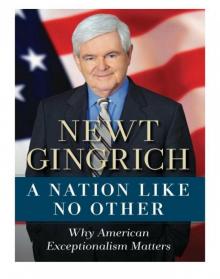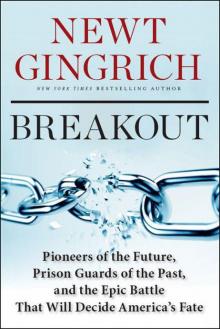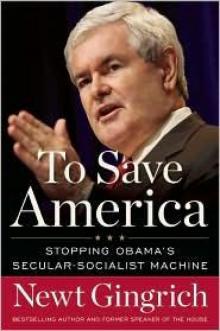- Home
- Newt Gingrich
Understanding Trump Page 10
Understanding Trump Read online
Page 10
Just look at the following MSNBC headlines after the election: “Trump Slams the Author of a Report He Hasn’t Read, Doesn’t Understand”; “Does Donald Trump Understand His Own Executive Orders?”; “Even Now, Trump Struggles to Understand the Basics of Unemployment.” These are all from the month of January.
Perhaps the only self-aware political assessment made by the elite during the 2016 cycle came from Larry J. Sabato, the director of the University of Virginia’s Center for Politics.
“If Trump is nominated, then everything we think we know about presidential nominations is wrong,” Sabato wrote on August 13, 2015, on the Center for Politics Sabato’s Crystal Ball website.
So far, we are seeing the same elite propagandists who were wrong about the primary, wrong about the election, and wrong about the president’s cabinet picks, trying to paint Trump’s presidency as chaotic. Think about this: if a sports analyst consistently misreported games he or she observed, he or she would not be a sports analyst anymore. Yet news reporters face no consequences for consistently misreporting politics.
SUBJECT BIAS
Clearly, not every journalist is a liberal propagandist seeking to push his or her own narrative. I have great respect for real journalists, who genuinely want to inform the public about the actions of their government. But some reporters create traps for themselves, and their editors are letting them fall in. Just look at the way news organizations large and small have approached stories about illegal immigration. Virtually every news agency in the country has written at least one story about what it’s like to be an illegal immigrant in its community.
These stories are formulaic. First, reporters introduce the local person here illegally as the main character. Then they detail the hardships he or she endured to get to our country and highlight how hard it is to find safe work and housing without proper documentation. The reporters then explain how terrible it would be for the main character to return to his or her own country, and they finish by talking to lawmakers about how and if this person’s life should be made easier or worse through legislation.
Not surprisingly, the New York Times has mastered the model. Here’s an example from June 8, 2014, by Damien Cave. The story is dramatically titled “An American Life, Lived in Shadows”:
Ignacio, a father of four, bounces along in his pickup truck, driving at exactly the speed limit through an aging suburb. The clock says 6:44 a.m. Religious pendants hang off the mirror. His teenage son sits beside him, chatty if half-awake, as they approach an apartment building for a day of roofing in dire heat.
A police cruiser suddenly appears to the right. Ignacio stays quiet, hands on the wheel, but in his mind he repeats the prayer that covers his 12 years living here illegally: “No me pare, no me pare”—“Don’t stop me, don’t stop me.”
“We used to have such a comfortable life, money to pay for our house, the car, to go wherever we wanted,” Ignacio says, referring to a time before Oklahoma’s 2007 law against illegal immigrants forced him to close his successful hair salon. “Now we are biting our nails, trying to make enough money every month.”6
In many cases, these stories are remarkable, interesting, and compelling. They are full of conflict, determination, and great struggle. As a community, reporters then pat each other’s backs for telling the stories of the downtrodden. So, journalists get awards for writing personal stories about people here illegally. Other journalists then see the praise their peers get and think, “I bet I can write a story about an undocumented immigrant in my community,” and the cycle continues.
Meanwhile, people in middle America who are constantly reading, watching, and listening to these stories sit and think, “What about me? I haven’t had a job in months. I’m having trouble paying for housing. I’m a legal American. I’m following all the laws, and I’m still struggling.”
The inherent bias betrayed by these “day in the life” stories are clear as day to the American people. So some news organizations drop the premise altogether.
Just look at the first three paragraphs of this story on the website for PBS Kids titled “Immigration: Living Undocumented.”7 I’m not entirely certain which aspect of this “news” story is most alarming: that it was paid for with tax dollars or that it’s a clear effort to indoctrinate children with liberal immigration policy.
You may have heard the term ‘illegal immigrants’ in the news or mentioned by adults. What does that mean, exactly? How can a person be illegal?
It’s kind of a weird thing to call someone, so we choose to use the term “undocumented immigrants,” meaning they don’t have the official paperwork that allows them to live in a new country. When immigration through legal channels is too expensive, complicated, or slow, or when the situation is too desperate, people are often left with this option.
Do you picture undocumented immigrants sneaking across national borders in the dark of night or hidden in a truck? This does happen. But just as often, families will enter a new nation as visitors and then choose to stay for good. For many, this new life is better than where they lived before, but it usually has serious challenges and dangers too.
This narrative is designed to build sympathy for people here illegally while ignoring border patrol agents whom we pay to keep them out, taxpayers who pay for their health care through hospital funding, legal immigrants who are inappropriately stigmatized by the actions of rule breakers, and a host of other Americans negatively affected. And, of course, doing sympathetic in-depth stories about people robbed, raped, or killed by criminal aliens would be shunned by most reporters and their editors. In Germany, this led to the suppression of stories about 2,500 assaults on New Year’s Eve 2015. Only when social media boiled over with anger about victims and eyewitnesses did the media and the government reluctantly admit it had happened.
It was this deep cultural bias in the media that Trump had to overcome with his campaign.
TRUMP’S MEDIA WORK-AROUND
Media organizations are quickly learning that Trump doesn’t need them to communicate with Americans.
As of February, Donald Trump had 25.4 million followers on his personal Twitter account and 15 million on his @POTUS account. He had 21 million people who liked his personal page on Facebook. During the campaign, he was able to leverage that network of people to bypass cable news media (and avoid paying for publicity). He would tweet out plans to hold a rally somewhere, and thirty thousand people would show up—all with smartphones. Those people would then post pictures and status updates about the rally, showing their enthusiasm for Trump, and influencing their personal networks.
When you start examining the number of people Trump was reaching through those networks, it is truly breathtaking. Pew Research Center said in its Social Media Update 2016, which was published three days after the election, that 86 percent of Americans used the Internet, and 79 percent of those people use Facebook.8 The survey of 1,520 adults living in the United States found that 32 percent of adults who used the Internet have Instagram accounts, and 24 percent use Twitter.
Brandwatch, a social media–focused marketing company, reported that as of March 2016, the average Facebook user had 338 friends. The median Facebook friend figure was 200, and at the same time, the company reported the average Twitter user had 208 followers.9
So, based on those statistics, we can estimate that 25,800 people at a 30,000-person Trump rally used the Internet. Of those Internet users, 20,382—or 79 percent—used Facebook and had approximately four million friends combined (using Brandwatch’s median figure to adjust for friend-heavy outliers like Trump).
That’s a bigger potential audience than any of the cable news channels—all from one rally.
If the media continues to present a false vision of the president, Trump should be prepared to break up the liberal media’s monopoly on White House coverage.
If members of the media don’t step back and reconsider how they plan to cover President Trump, they will be locked in a war with the admin
istration for as long as he is in office.
You’ve seen already that Trump is not backing down. During a speech at the Conservative Political Action Conference, he told the crowd the media was “the enemy of normal Americans.”
In February, he informed the press he would not be joining them for the annual White House Correspondents Dinner. The dinner is traditionally a roast of the president, but that’s now everyday programming in today’s propaganda media.
Sean Spicer may have the most difficult job in Washington. He has to contend all day with people who deeply oppose President Trump, are hostile to the Trump agenda, and constantly look for opportunities to attack or belittle the president and his team.
The Trump team should redefine the entire process of communicating with the country. There is no reason the White House press corps should be dominated by elite media hostile to the president. Membership can be dramatically broadened to include local media organizations from across the country and alternative conservative media. Skype and FaceTime could be used to allow one or two citizens to ask questions at each press briefing.
A lot can be done to open up the process.
Candidate Trump had consistently underestimated the depth of genuine hostility from the Left. He still had a childhood sense that if you ran a hard race, then everyone would rally around the winner. Again and again, some bad story would come up that accused him of racism or bigotry, or some good story would be ignored, or some totally phony charge of him treating past female employees badly would dominate the news for several days. He would express surprise and frustration. Every time, I would say to him, “These people are your mortal enemies. You represent the end of their world. They will never give up as long as you are in office.” While what I was saying was accurate, it so conflicted with Trump’s childhood civic lessons he still can’t completely accept it.
CHAPTER SIX
TOXIC IDENTITY POLITICS
There has been a fundamental shift in the way that liberals approach civil rights.
This shift has twisted a unifying movement that favors equal rights for all people into a brand of toxic identity politics, which is dividing the nation along racial, religious, sexual and gender lines.
No moment in the 2016 campaign captured the divisive nature of identity liberalism better than Hillary Clinton’s description of half of Donald Trump’s supporters as “deplorables” who were “racist, sexist, homophobic, xenophobic, Islamophobic—you name it” and who were “irredeemable.”
The election of Donald Trump was due in part to a national rejection of this identity-based liberalism.
Liberalism did not always take this approach. The civil rights movement of an earlier generation attracted a broad-based coalition of Americans. It succeeded in passing the landmark Civil Rights Act of 1964, which outlawed discrimination by race, sex, color, religion, or national origin. The law attracted overwhelming bipartisan support. Sixty-three percent of Democrats and 80 percent of Republicans supported the legislation in the House of Representatives, while 69 percent of Democrats and 82 percent of Republicans supported it in the Senate.
That generation of civil rights leaders also succeeded in passing the overwhelmingly bipartisan Equal Pay Act of 1963, which outlawed paying women less than men for the same work. It was passed by voice vote in both the House and Senate. (An earlier version of the bill attracted support from 79 percent of Democrats and 90 percent of Republicans in the House.)
This civil rights movement succeeded because it was firmly rooted in America’s founding principles. It was a direct call to the Declaration of Independence’s affirmation of the “self- evident” truth that “all men are created equal.” It was dedicated to a vision of a color-blind society in which, as Dr. Martin Luther King Jr. put it, his children “will not be judged by the color of their skin, but by the content of their character.”
That vision of a color-blind society with equal rights for all has now been abandoned by the Left in favor of a race- and gender- obsessed insurrection against American ideals.
Today, the Left says that statements expressing the desire for Dr. King’s color-blind society are racist.
The University of California’s guide titled “Recognizing Microaggressions and the Message They Send,” for example, says that statements such as “When I look at you, I don’t see color” denies “the individual as a racial/cultural being.” The Left has shifted from judging people by the content of their character to believing that we are defined by our race.
Psychology Today published an article in 2011 titled “Color-blind Ideology Is a Form of Racism.”1
Identity liberalism also rejects the idea of America as a “melting pot”—a phrase coined by a Jewish immigrant from England in 1908 to describe the idea that all immigrants can learn to become Americans by adopting key national values while at the same time strengthening the American character by bringing the best of their native culture to their new home.
Instead, the Left opposes assimilation and instead aspires for a country in which all subgroups of Americans—defined by their race, nationality, religion, sexuality, and so forth—never shed their differences to become one people. It is a recipe for the balkanization of America—for conflict, not unity.
I was born in Harrisburg, Pennsylvania, and grew up as an army brat. The army was integrated, and I routinely went to school with African Americans. It was a real shock to transfer in 1960 as a junior from Stuttgart, Germany, to Fort Benning, Georgia. The army base was integrated, but the state of Georgia was legally enforcing segregation. There were white and black bathrooms, water fountains, schools, and so forth. It did not make for a united community.
Over the last twenty years, the Left has shifted from being antisegregation and prointegration to championing a new desire for racial identity and the new segregation. Black students at the University of Michigan demand a racially segregated space for blacks only. On campus after campus, courses are being offered that are explicitly antiwhite.
The toxic nature of identity liberalism is why most Americans view race relations as worse now than in decades past.2 This is tragic, because as the nation’s first African American president, Barack Obama had the opportunity to help heal the nation of its racial divides.
Unfortunately, this didn’t happen, because the Left learned the wrong lessons from his election.
LEARNING THE WRONG LESSONS FROM THE OBAMA VICTORY
Barack Obama’s overwhelming victory in 2008 was a cultural watershed that inspired hope for millions of Americans.
I attended his January 2009 inaugural and remember looking out at the vast crowd. Seeing that level of support from Americans looking for change, I told Callista as we left the Capitol that if Obama governed from the center, he could split Republicans in the House and Senate and build an enduring Democratic governing majority for decades.
As president, Obama did anything but govern from the center. Instead of enacting mainstream policies to solidify his broad-based support, he pursued what I described in an earlier book as a “secular-socialist” agenda that alienated key segments of the people who had voted for him in 2008.
But it wasn’t just Obama and the Left’s policies that alienated Americans, it was their politics. The Left, and the Democratic Party apparatus that is its vehicle, decided a permanent Democratic majority could be built mainly on the strength of blacks, Hispanics, college-educated women, sexual identity politics, and young liberal voters—leaving out the rest of the broad coalition Obama had built in 2008.
This conclusion was tempting to draw because it was precisely what two liberal writers predicted in a 2002 book called The Emerging Democratic Majority. The authors argued that demographic trends would guarantee Democratic Party dominance as the country became less white over time. The election of an African American president by a coalition of young liberals and minorities seemed to prove their thesis.
But as Nate Cohn wrote for the New York Times in December 2016, the “core of the Obama
coalition” was not a massive voting bloc of minority voters. It was “an alliance between black voters and Northern white voters.” Specifically, Cohn pointed to non–college educated working-class white voters in the upper Midwest.
The Left overlooked this fact and pursued a strategy of base mobilization by doubling down on explicitly identity-oriented politics. Rather than finding unifying fights that attracted broad-based support based on mutual self-interest and common values, the Left obsessed over race and gender issues. The Democrats embraced Black Lives Matter, put gay marriage and transgender issues front and center, and painted those who disagreed with them as haters.
By focusing so much of its rhetoric on explicitly identity-based appeals, the Left forgot to study the actual message that Obama had used to build his winning coalition.
The truth is that as a candidate in 2008, Obama was very careful to avoid explicitly identity-oriented politics. His approach on matters of race was usually framed within universal American values and tried to avoid divisiveness.
Ta-Nehisi Coates is a very left-wing black activist and author. He wrote an article in January 2017 reflecting on what it meant, as a black man, to have an African American president. I suspect I don’t agree with Coates on very much, but his observations about Obama’s approach to issues involving race are very astute.
In the article, Coates calls Obama “the most agile interpreter and navigator of the color line I had ever seen. He had an ability to emote a deep and sincere connection to the hearts of black people, while never doubting the hearts of white people.”3
Coates had an opportunity to interview the former president for the article. When discussing how his early work as a community organizer in Chicago affected him, Obama told Coates:

 1945
1945 Collusion
Collusion Trump's America
Trump's America Shakedown
Shakedown A Nation Like No Other
A Nation Like No Other To Try Men's Souls - George Washington 1
To Try Men's Souls - George Washington 1 Pearl Harbor: A Novel of December 8th
Pearl Harbor: A Novel of December 8th Valley Forge: George Washington and the Crucible of Victory
Valley Forge: George Washington and the Crucible of Victory To Save America
To Save America Grant Comes East cw-2
Grant Comes East cw-2 Victory at Yorktown: A Novel
Victory at Yorktown: A Novel Days of Infamy
Days of Infamy The Battle of the Crater: A Novel (George Washington Series)
The Battle of the Crater: A Novel (George Washington Series) Breakout: Pioneers of the Future, Prison Guards of the Past, and the Epic Battle That Will Decide America's Fate
Breakout: Pioneers of the Future, Prison Guards of the Past, and the Epic Battle That Will Decide America's Fate Pearl Harbour and Days of Infamy
Pearl Harbour and Days of Infamy Pearl Harbour - A novel of December 8th
Pearl Harbour - A novel of December 8th Understanding Trump
Understanding Trump To Save America: Abolishing Obama's Socialist State and Restoring Our Unique American Way
To Save America: Abolishing Obama's Socialist State and Restoring Our Unique American Way